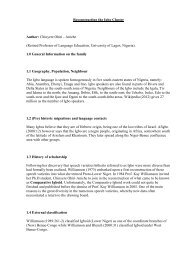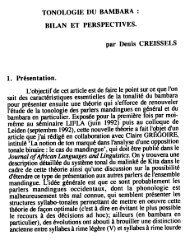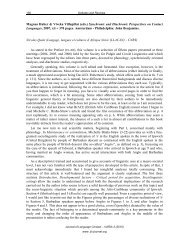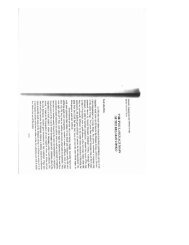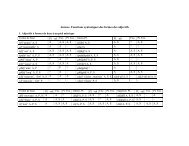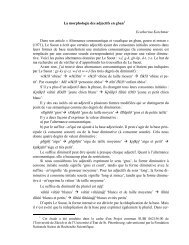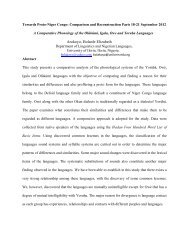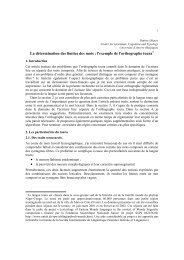1 A LINGUIST'S FIELD NOTES INTRODUCTION ... - Llacan - CNRS
1 A LINGUIST'S FIELD NOTES INTRODUCTION ... - Llacan - CNRS
1 A LINGUIST'S FIELD NOTES INTRODUCTION ... - Llacan - CNRS
Create successful ePaper yourself
Turn your PDF publications into a flip-book with our unique Google optimized e-Paper software.
elying on Schneeberg’s work to begin the study of this language. Discouraged, I could<br />
not believe that a language could be so complicated. I tended therefore to have more<br />
confidence in Shimizu, who marked only two tones with downstep («faille tonale» in<br />
French) in his list of 200 words drawn from the basic vocabulary.<br />
At the beginning of my work with Eski, I had come to the conclusion that the<br />
language operates a tonal system of two distinct tones. I soon discovered that the<br />
system was much more complex, and that it probably had three significant pitches<br />
(High, Mid and Low), with a possibility of a combination of two tones on a single<br />
syllable. Things were complicated because of vocalic length. Since length was<br />
significant, tonal modulation was theoretically possible over both short and long<br />
vowels.<br />
Let V represent short vowels, VV long vowels and C consonants. The syllables that<br />
are theoretically possible are of the type CV and CVV (open syllables), CVC and<br />
CVVC (closed syllables). The tonal modulations are heard relatively easily over the<br />
long vowels, the closed syllables ending with a voiced consonant (only sonorous<br />
segments carry melody). But they are difficult to hear over syllables with a short vowel,<br />
whether they are open (CV) or closed with a voiceless consonant (CVC).<br />
At this stage of the research work with Eski, I had not yet defined these problems. I<br />
was simply hearing the tonal changes, which I was just beginning to pick up. Over the<br />
long vowels, I was hearing and distinguishing contrasts between three significant levels<br />
and two modulations: one rising and one falling. I could not say whether it was a<br />
Low-High modulation, Mid-High or Low-Mid for the rising modulation, nor whether<br />
these three modulations were present and had meaning in the language. The same thing<br />
was applicable to the falling modulations, with the registers High-Low, High-Mid and<br />
Mid-Low. With regard to the difficult syllables (CV or CVC with a voiceless final<br />
consonant), I could not say whether I was dealing with a flat or a modulated tone.<br />
Tonal contrasts are found to be very important in this language. The conjugation<br />
paradigms are an illustration of this. As in many Chadic languages, conjugation comes<br />
in the form of prefix morphemes attached to the verb, to mark aspect, tense, mood,<br />
number and person.<br />
14


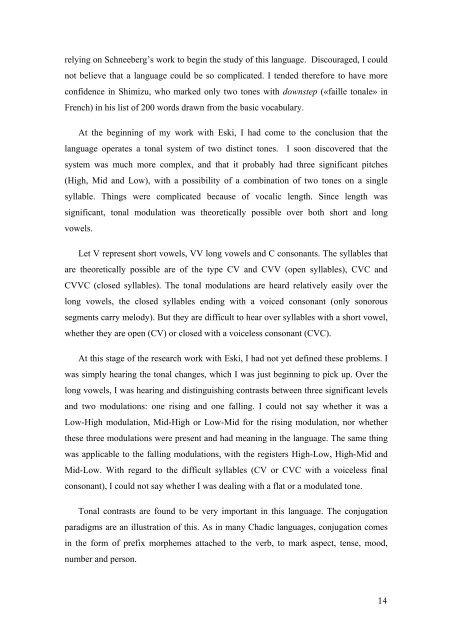
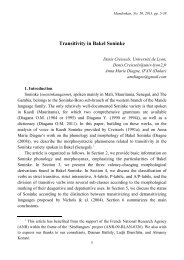
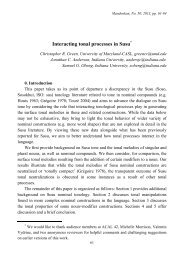
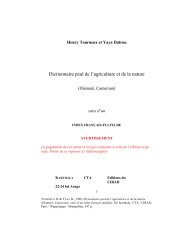
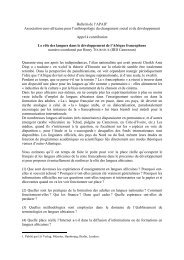
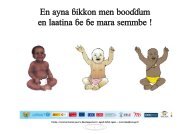
![[halshs-00645129, v1] Depressor consonants in Geji - Llacan - CNRS](https://img.yumpu.com/17832391/1/190x245/halshs-00645129-v1-depressor-consonants-in-geji-llacan-cnrs.jpg?quality=85)
